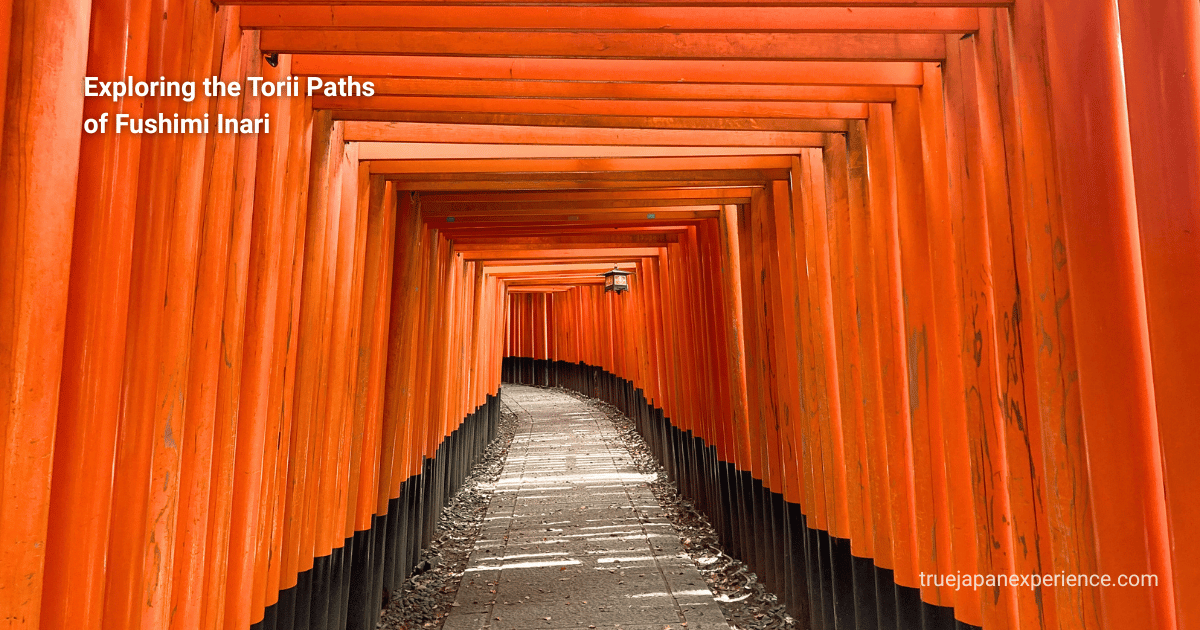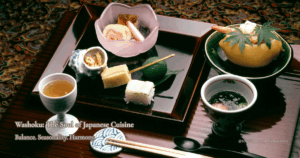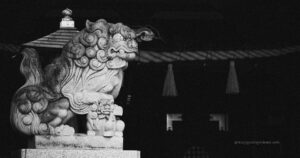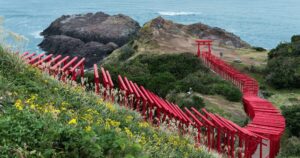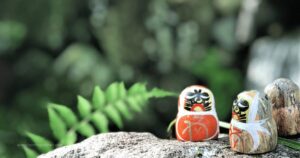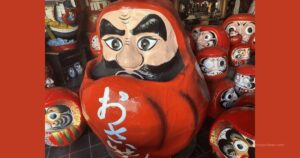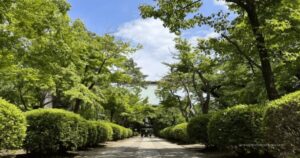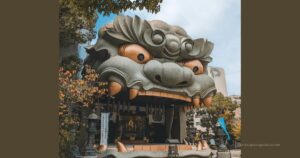Discover Fushimi Inari Taisha, Kyoto’s iconic shrine known for its endless red torii gates and mystical fox guardians. Plan your perfect visit with cultural tips, hidden spots, and must-see routes.
Introduction
Fushimi Inari Taisha is Kyoto’s most iconic shrine, famous for its thousands of red torii gates and mystical fox guardians. Located at the foot of Mount Inari, this sacred site attracts millions of visitors every year.
If you’ve ever seen a photo of Japan featuring endless rows of vibrant red gates winding up a forested hillside — you’ve already glimpsed Fushimi Inari Taisha. Located just outside central Kyoto, this legendary Shinto shrine is one of the most photographed and spiritually significant places in the country.
Famous for its thousands of vermilion torii gates and mysterious fox guardians, Fushimi Inari isn’t just visually stunning — it offers a deep connection to Japan’s culture, beliefs, and timeless traditions. Whether you’re a first-time visitor or a seasoned traveler, a walk through these gates is an unforgettable experience.
But what’s the story behind all those fox statues? Why are there so many torii gates? And is it really a good idea to visit in a rented kimono? Let’s dive into everything you need to know before visiting Fushimi Inari Taisha.
What Is Fushimi Inari Taisha?
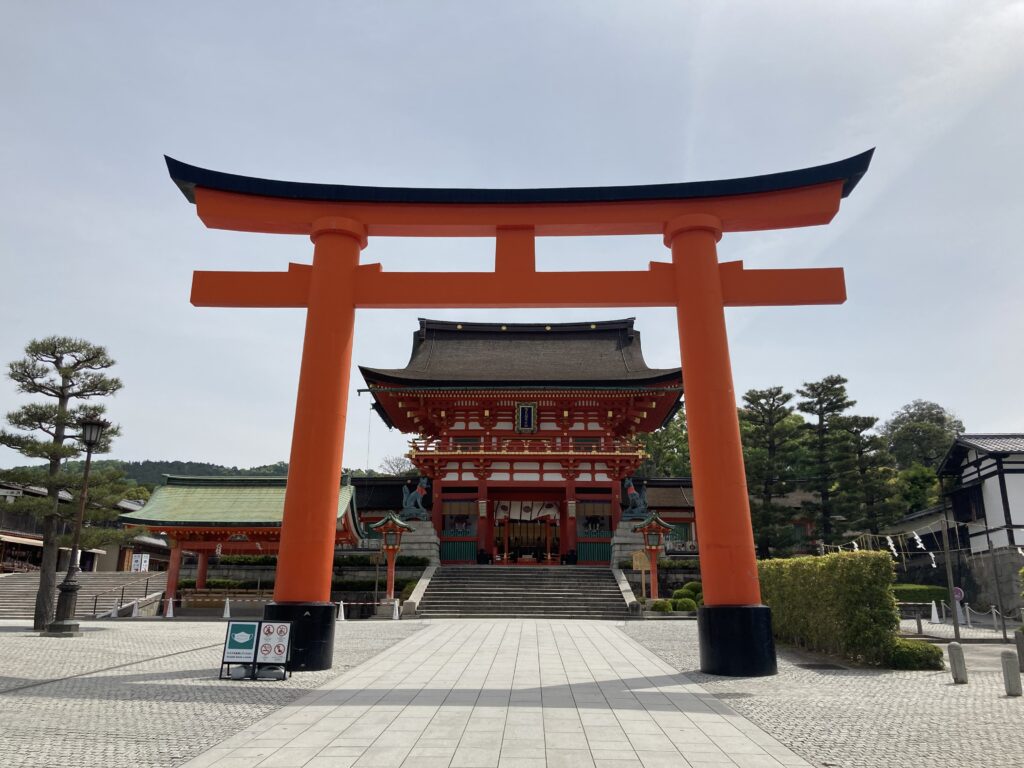
Fushimi Inari Taisha is the head shrine of over 30,000 Inari shrines across Japan. Established in 711, it is dedicated to Inari Ōkami, the Shinto deity associated with rice, agriculture, and prosperity — especially in business.
Like most Shinto shrines, Fushimi Inari is open 24/7 and free for visitors to enter. However, what sets it apart is its extensive network of hiking trails leading up Mount Inari, where thousands of torii gates form a mesmerizing path through the forest.
Visitors come not only to admire the iconic gates but also to experience the peaceful, almost otherworldly atmosphere as they ascend the mountain.
Why Are There So Many Torii Gates?
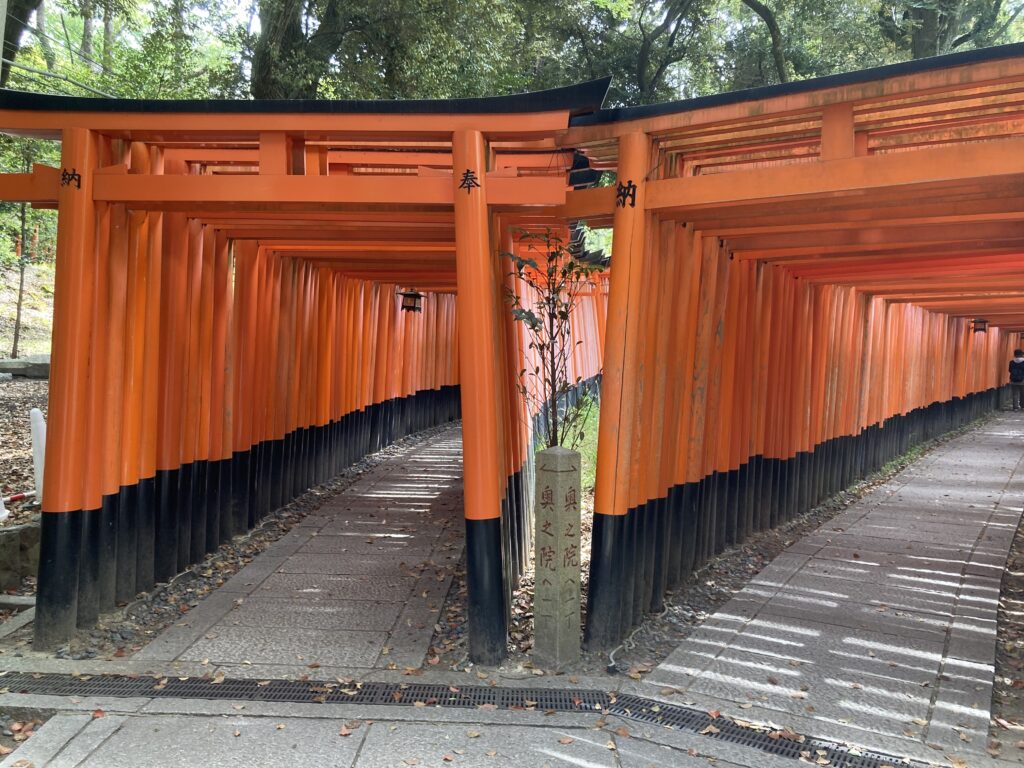
One of the most fascinating features of Fushimi Inari is its sea of vibrant red torii gates stretching up the hillside. These gates are not just for decoration — each one is a personal donation from an individual or company seeking blessings for prosperity, success, or gratitude for fulfilled wishes.
The tradition of donating a torii gate started in the Edo period (1603–1868) and continues even today. Donors’ names and the dates of their contributions are inscribed in black on the gates, turning the entire path into a living record of faith and gratitude.
Walking through the dense rows of torii, especially at dawn or dusk, feels like stepping into another world — a quiet, sacred space suspended between the human and the divine.
While the “Senbon Torii” (“Thousands of Torii Gates”) area near the main shrine is the most famous spot for photos, the gates continue much further up the mountain, offering quieter and more spiritual experiences the higher you climb.
Who Is the God of Fushimi Inari?
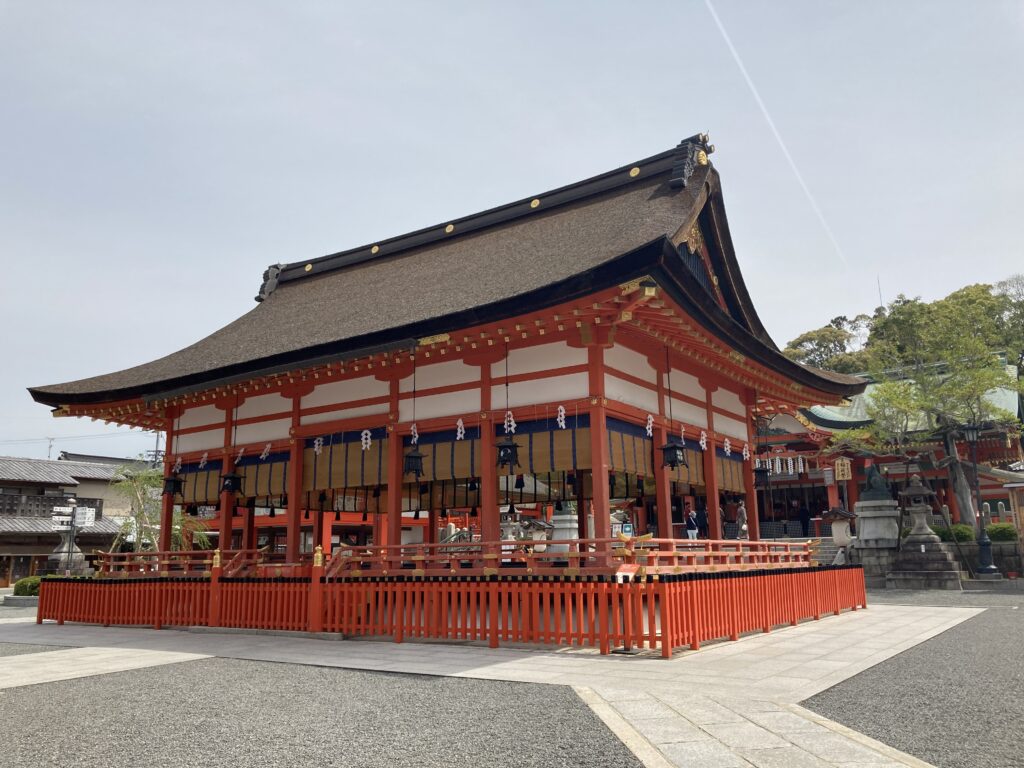
At the heart of Fushimi Inari Taisha is the worship of Inari Ōkami, one of the most beloved deities in Shinto belief. Inari is associated with rice — a symbol of life, wealth, and abundance in Japan — and by extension, business prosperity, agriculture, and even household well-being.
Interestingly, Inari’s appearance is not fixed. Sometimes depicted as a male, sometimes as a female, and sometimes as an androgynous figure, Inari’s form is believed to change according to the needs and prayers of each worshipper. This flexibility reflects the deeply personal relationship between the deity and the people.
Inari shrines are easily recognized by the presence of fox statues (kitsune), but it’s important to note: the foxes are not gods themselves. They are sacred messengers of Inari, believed to carry prayers between the human world and the divine realm.
The keys, scrolls, or jewels often found in the mouths of the fox statues represent treasures, wisdom, and the safeguarding of rice granaries — all vital for prosperity and survival in ancient Japan.
The Fox Statues and Their Mysterious Meanings
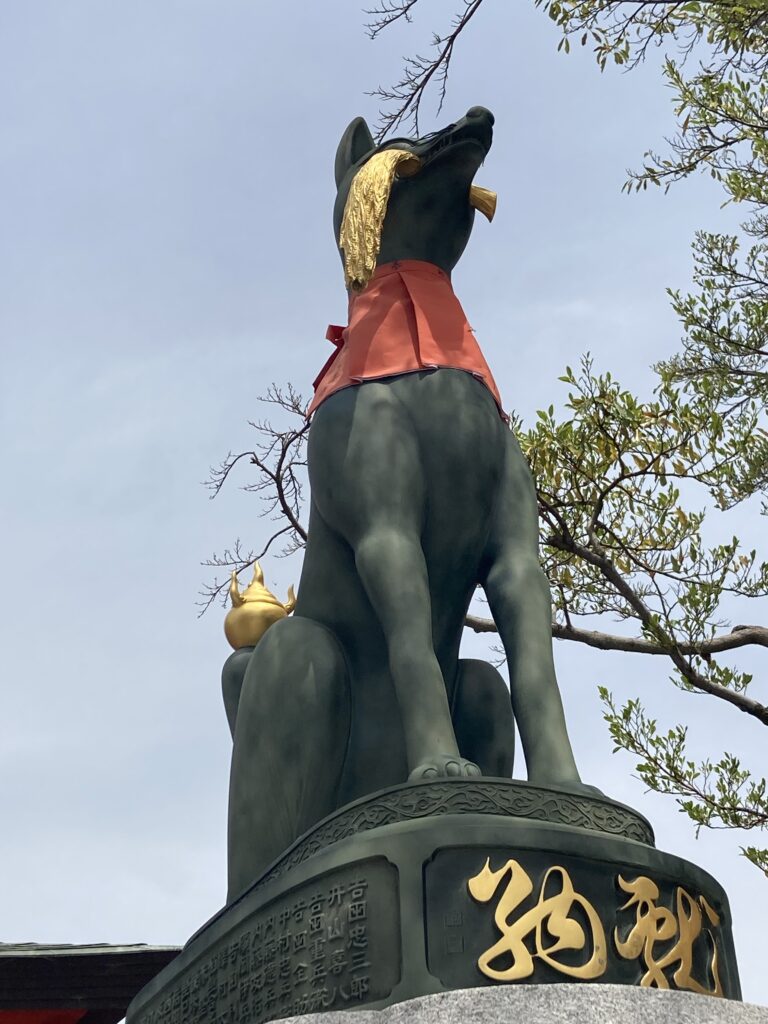
As you explore Fushimi Inari Taisha, you’ll see countless fox statues placed at shrine entrances and along the mountain paths. In Inari worship, foxes (kitsune) are not gods themselves but sacred messengers connecting humans with the divine.
At first glance, many of the fox statues might look similar. However, if you take a closer look, you’ll notice an important detail — the objects they hold in their mouths vary, and each carries a different symbolic meaning:
A key: Symbolizing the key to the rice granary, and by extension, wealth and abundance.
A jewel: Representing spiritual power and the ability to grant wishes.
A scroll: Signifying wisdom and sacred knowledge.
These subtle differences reflect various blessings that visitors may pray for, whether it’s success, prosperity, or guidance.
It’s important to remember that the role of the fox as a sacred messenger is unique to Inari shrines. In broader Japanese folklore, foxes can have many different personalities — from mischievous tricksters to protective spirits — but here at Fushimi Inari, they are honored for their role in bringing prosperity and good fortune.
While you’re here, don’t miss the chance to write your wish on a small fox-shaped ema (votive plaque) — you can even draw your own fox face to personalize your prayer!
Exploring the Shrine Grounds and Hidden Spots
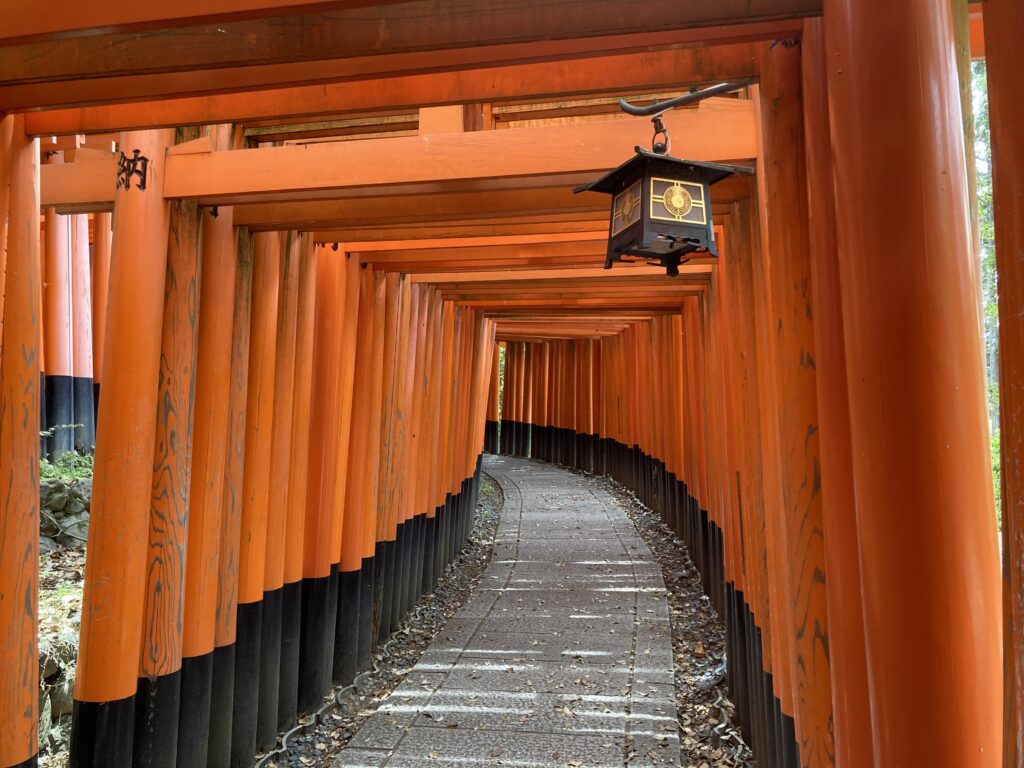
The journey through Fushimi Inari Taisha begins at the grand Rōmon Gate, a towering entrance donated by the famous samurai leader Toyotomi Hideyoshi. Beyond it lies the main shrine building (Honden), where visitors offer prayers for prosperity, good health, and success in business.
From there, the real adventure starts.
Passing through the Senbon Torii — the famous “Thousands of Torii Gates” — you’ll enter a mesmerizing tunnel of vibrant vermilion gates. This path winds up the slopes of Mount Inari, leading you deeper into a sacred atmosphere with every step.
While the first part of the trail is relatively gentle, the climb soon becomes steeper, with stone staircases, uneven paths, and narrow forest trails. Wearing comfortable walking shoes is highly recommended. Even if you rent a kimono for the day, many visitors choose to wear sneakers instead of traditional sandals (zōri) to make walking easier.
However, keep in mind that kimono itself — even for Japanese people — is not the most practical outfit for hiking, as the tight fit restricts movement and makes climbing tiring.
Midpoint: Okusha Hohaisho (奥社奉拝所)
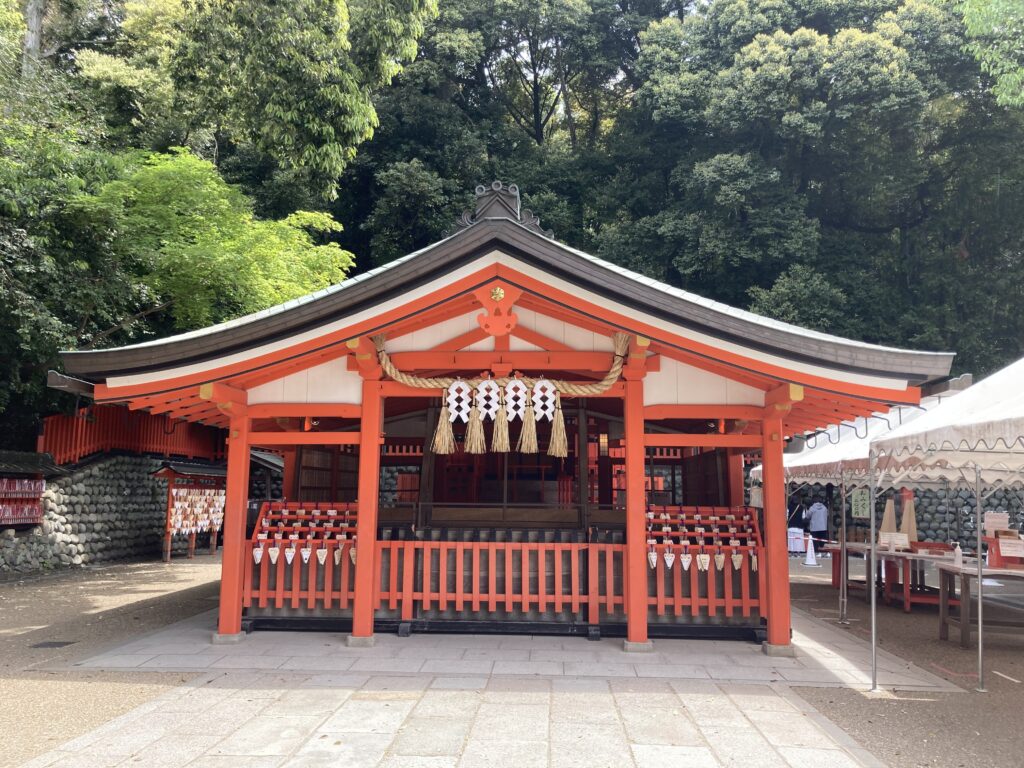
After passing through the densest stretch of torii gates, you’ll reach the Okusha Hohaisho, often simply called the Inner Shrine.
This sacred spot is a natural resting point for many visitors, offering a sense of accomplishment after completing the iconic “torii tunnel.”
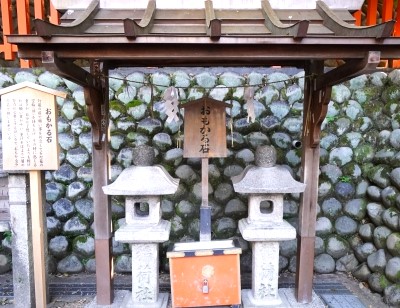
At Okusha Hohaisho, you can also try the famous omokaru ishi (“heavy-light stones”).
The idea is simple: make a wish, then lift the stone.
If the stone feels lighter than expected, your wish will come true easily.
If it feels heavier, it might take more effort to achieve your goal.
This small ritual is one of the most popular experiences at Fushimi Inari.
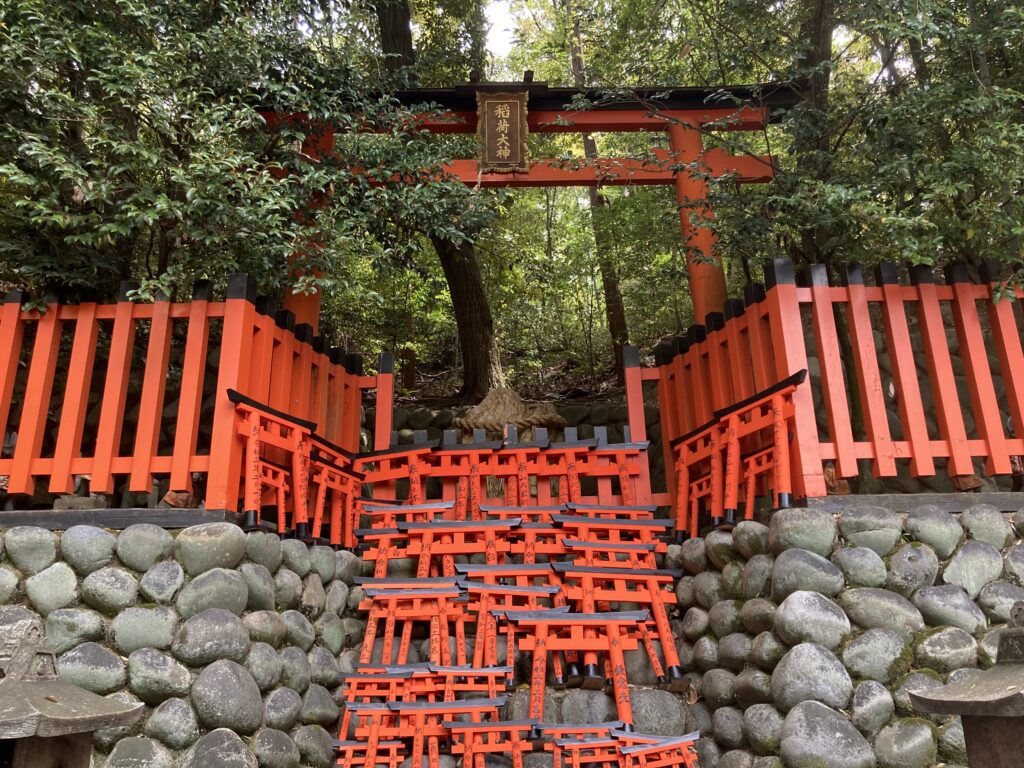
Just behind the main building of the Okusha Hohaisho, near the omokaru ishi, you’ll also find a quiet corner where miniature torii gates have been offered — deeply atmospheric spot worth pausing to appreciate.
Many visitors choose to end their visit here and head back down, but for those seeking a deeper and quieter experience, the trail continues further up the mountain.
Hidden Gem: Kandaka Shrine (神宝神社)
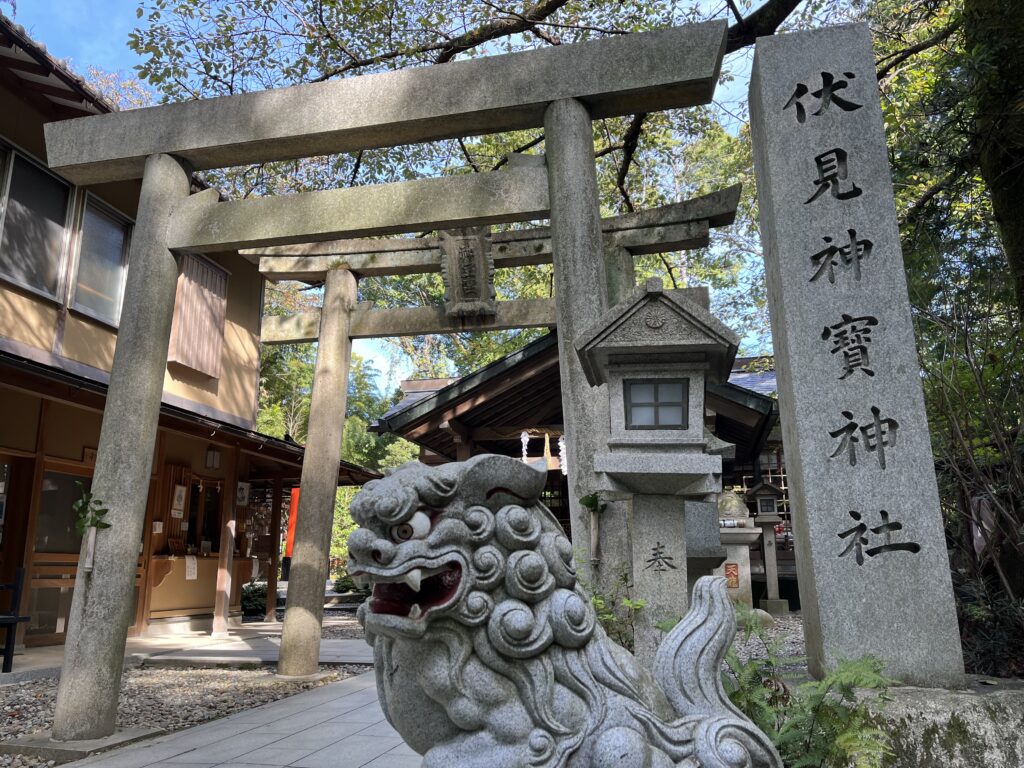
As you climb higher beyond the Inner Shrine, a hidden gem awaits — Kandaka Shrine.
Tucked away from the main trail, this small, peaceful shrine is believed to bring luck in business and financial matters.
Unlike the busy lower areas, Kandaka Shrine offers a serene, secluded atmosphere.
Keep in mind that the paths here are less maintained and can be slippery when wet, so take extra care while exploring.
Even if you rent a kimono for the day, walking the paths at Fushimi Inari can be quite challenging without wearing comfortable shoes like sneakers.
The shrine grounds involve many stairs, slopes, and uneven surfaces, which can make it tough to move freely in traditional attire.
Kimono, while beautiful, is not designed for active movement.
The tight wrapping around the legs can make it hard to take big steps, and if not properly fitted, the hem may come loose as you walk.
If you’re wearing a rented kimono, it’s best to stay around the lower areas of Fushimi Inari for photos — such as the Rōmon Gate, the main shrine (Honden), and the first part of the famous Senbon Torii trail.
The trails beyond quickly become steeper with many stairs and uneven paths, making it difficult to walk comfortably in traditional attire.
For the best experience, enjoy your kimono photos at the entrance and main shrine area, and avoid climbing too far up the mountain while dressed in traditional clothing.
Recommended Visit Routes
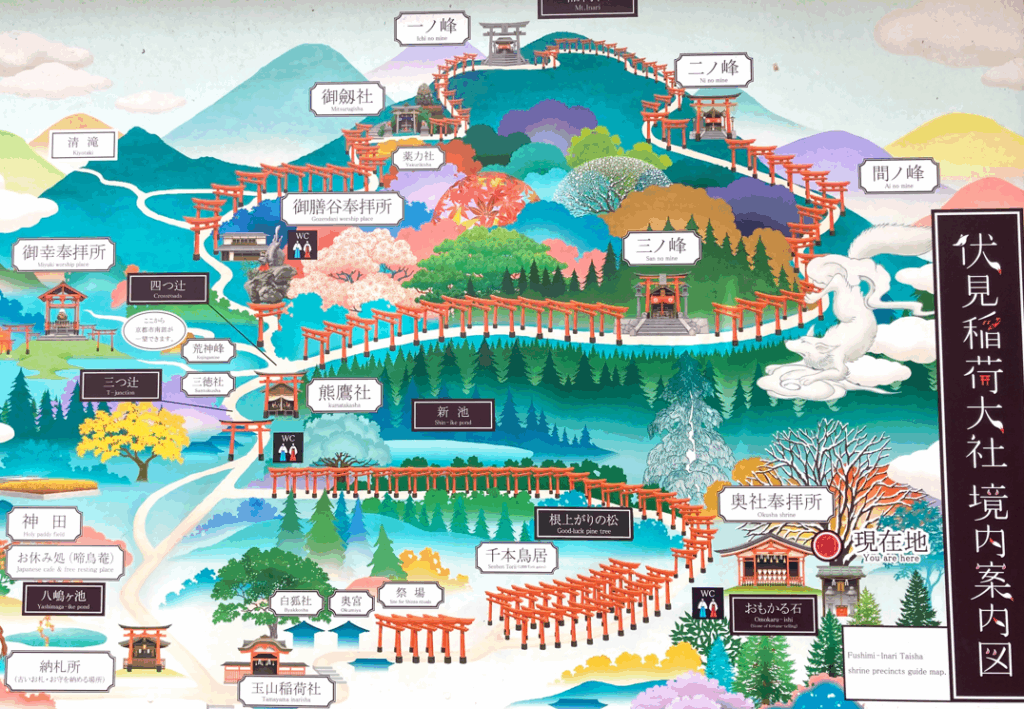
For most visitors, exploring the main shrine grounds and the lower mountain area is more than enough to experience the spirit of Fushimi Inari.
However, if you have extra time and stamina, there are deeper routes to enjoy.
Main Shrine and Senbon Torii Route (Approx. 30 minutes)
A light and easy route exploring the main shrine (Honden) and the famous first section of the Senbon Torii (Thousands of Torii Gates).
Perfect for visitors who prefer a short and relaxed visit without strenuous climbing.
Inner Shrine (Okusha Hohaisho) and Fushimi Kandaka Shrine (伏見神宝神社) (Approx. 45–60 minutes)
After walking through the densest area of torii gates, you’ll reach the Inner Shrine (Okusha Hohaisho), a popular resting point where you can try the omokaru ishi (wish stones).
Just a few minutes’ walk beyond the Okusha Hohaisho (Inner Shrine), you’ll find the Fushimi Kandaka Shrine (伏見神宝神社) — a hidden, peaceful spot believed to bring good fortune in business and finances.

Near this shrine, you can also enjoy a small bamboo grove.
Unlike the famous Arashiyama Bamboo Grove in western Kyoto, which is often crowded with tourists, the bamboo forest here offers a quiet, refreshing atmosphere — perfect for those who want to experience Kyoto’s natural beauty without the crowds.
It’s a lovely bonus for visitors who make the short walk beyond the main shrine area.
This short detour is perfect for those who want to explore a quieter side of Fushimi Inari without committing to a long mountain hike.
Yotsutsuji Intersection (Approx. 1.5 hours) [Optional]
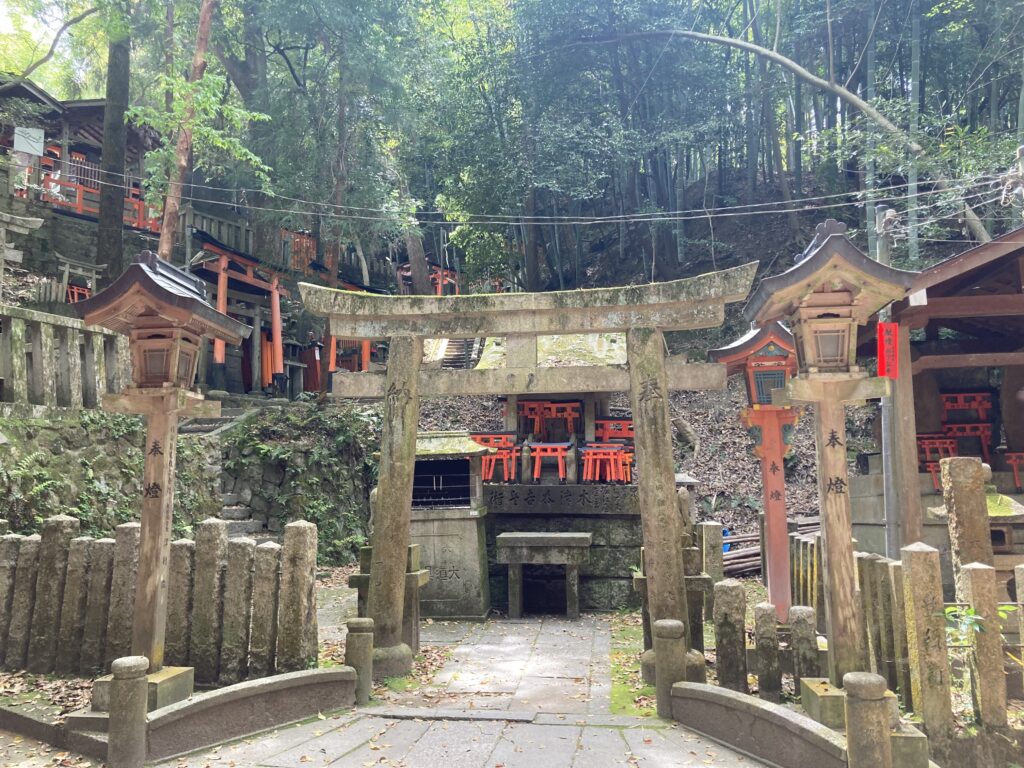
If you feel adventurous, you can climb further to the Yotsutsuji Intersection, about halfway up Mount Inari.
Here, a panoramic view over Kyoto city awaits.
Please note that most visitors do not go beyond the Inner Shrine area, and the trail beyond becomes steeper and more challenging.
If you have time and energy to go further, you’ll be rewarded with views of more secluded altars, weathered torii gates, and moss-covered stone lanterns — remnants of the shrine’s long and sacred history nestled deep in the forest.
Full Summit Route (Approx. 2 hours) [Optional]
For experienced hikers with enough time and energy, continuing all the way to the Ichinomine (First Peak) offers a deeper and quieter spiritual journey.
However, reaching the summit is not necessary to fully enjoy Fushimi Inari.
How to Get to Fushimi Inari Taisha
Fushimi Inari Taisha is conveniently located just south of central Kyoto and is easily accessible by public transportation.
Here’s how you can reach it:
🚉 From Kyoto Station
By JR Nara Line:
Take the JR Nara Line from Kyoto Station and get off at Inari Station.
The ride takes about 5 minutes, and the shrine entrance is directly across the street from the station.
By Keihan Main Line:
Alternatively, you can take the Keihan Main Line and get off at Fushimi Inari Station.
From there, it’s about a 5-minute walk to the shrine’s entrance.
Tip:
If you’re already staying near Gion or southern Kyoto, the Keihan Line can be more convenient.
🚄 From Osaka (Umeda/Namba Areas)
From JR Osaka Station:
Take the JR Kyoto Line to Kyoto Station (about 30 minutes by rapid train), then transfer to the JR Nara Line as described above.
From Namba (via Subway and Keihan Line)
Take the Osaka Metro Midosuji Line from Namba Station to Yodoyabashi Station (about 10 minutes).
At Yodoyabashi, transfer to the Keihan Main Line toward Kyoto.
Get off at Fushimi Inari Station.
The total travel time is about 50–60 minutes, depending on your train connections.
Tip:
Make sure to exit the subway station and enter the Keihan Railway platform at Yodoyabashi, as they are connected but operated separately.
Note:
While Fushimi Inari is easy to visit as a half-day trip from Osaka, it’s best to start early to avoid crowds, especially if you’re visiting in the morning.
Plan Your Visit
Tips for First-Time Visitors
Before you explore the thousands of torii gates and mountain trails, here are some useful tips to make your visit to Fushimi Inari Taisha more comfortable and respectful:
🥾 Wear Comfortable Shoes
The shrine grounds involve many stairs, stone steps, and uneven paths.
Even if you’re wearing a rented kimono, it’s best to choose comfortable footwear like sneakers.
🎎 Respect Shrine Etiquette
At Shinto shrines, there are a few basic manners to follow:
Bow once before entering through a torii gate.
Walk slightly to the side rather than in the center of the path (the center is considered the path for deities).
When praying, bow twice, clap twice, pray silently, then bow once again.
These simple gestures show your respect for the sacred atmosphere.
☔ Be Prepared for Weather Changes
The mountain paths are mostly outdoors and exposed to the elements.
Carry a small umbrella or raincoat if the weather looks uncertain, and wear shoes with good grip if rain is expected.
🎒 Travel Light
The walk to the summit involves a lot of stairs and narrow paths.
Carrying a heavy backpack can make the climb tiring and inconvenient.
Try to bring only essentials.
🕐 Time Your Visit Carefully
As mentioned earlier, the best time to visit is early in the morning.
If you plan to stay late, be aware that the trails are poorly lit after sunset, and shrine offices close at 6:00 PM.
